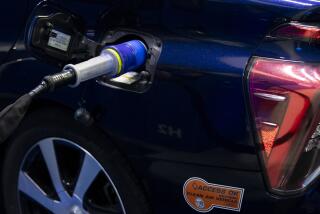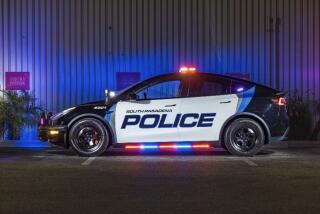Wimps No More : Technology: Creators of electric-powered cars gather their sleek, fast machines to show the world that these vehicles are just as macho as the gas-guzzling variety.
- Share via
SANTA MONICA — Electric cars have evolved from clunkers that could barely pull away from a stop sign to formula racers that reach speeds of 100 m.p.h. Both ends of the spectrum were displayed at Santa Monica College’s airport campus on Tuesday in a media event to promote an upcoming road race.
There was a 1911 Baker Electric Car, which was marketed as a nice car for women because of its limited range women didn’t need to go far) and quietness. The rumbling gasoline engine, which had to be started by turning a crank, was considered more macho.
The electric motor spelled its own doom when GM began using one to start up the gasoline engine of its Cadillac model. With the cantankerous arm-churning crank gone, there was nothing to stop the far-ranging gas engine from taking over.
But with millions of noxious gas-spewing cars on the roads today, electric-powered and alternative-fuel cars are making a comeback. All major car manufacturers have one in the works.
The dozen vehicles displayed Tuesday included an electric-powered Formula 440 car, electric motorcycles, and electric and alternative-fuel cars.
The event was a promotion for the 1992 International Electric Grand Prix, scheduled for mid-October. Race organizer Peter Quinn Hackes said he hoped the parade of techno-wonders from around the world would do away with the electric-car image as a “glorified golf cart.” During the race, the cars will travel on surface streets through 26 cities from Santa Monica to Riverside.
“These cars will drive that message right through their neighborhoods,” Hackes said.
Michael Hackelman, publisher of Alternative Transportation News magazine, said there are thousands of electric cars on the roads already, but no one knows they’re there. Few people notice the missing tailpipe, the quietness. So Hackelman encourages electric-car owners to put a sticker on their car the way that he does.
“I have guys who pull up alongside me and say, ‘Is that really electric?’ They give me the thumbs up and say, ‘All right!’ ”
Hackelman in a speech called for workplaces and gas stations to install battery rechargers. But he said the industry will not move forward until the public makes fighting pollution a priority.
“We have the technology, but we lack the political motivation,” he said. Who buys electric cars? Neil Sinclair, who owns northern California-based Solar Electric Engineering Inc., converts Fieros, Ford Escorts and trucks to run on electric power. The electric Escort sells for $18,700 compared to the list price of about $9,000 for a standard Escort. Prices for electric cars can vary widely, depending on the model and efficiency of the drive train.
Half the 115 cars Sinclair that has sold in the past few years went to government agency fleets. The agencies want to set a good example and must meet clean-air standards by reducing overall emissions of their cars.
The other half of his sales have been to doctors, lawyers, actors and other people who are what Sinclair calls “green consumers--people who vote with their dollars.”
Manufacturers like GM and Chrysler expect to begin marketing their electric cars by the mid-1990s. And it’s more than out of the goodness of their hearts.
State clean-air laws will require 2% of cars sold in 1998 to be electric-powered, according to Juan Osborne, an engineer with the state Air Resources Board.
That number will climb to 5% in 2001 and to 10% in 2003.
The cars will help meet federal clean-air goals, as vehicles emit 60% of the gases that make up smog, including carbon monoxide, hydrocarbons and various nitrogen compounds.
Unlike the major auto manufacturers, who jealously guard their electric-car technology, the engineers at the show were more than happy to reveal theirs.
One group tackled the battery problem. Their hydrogen fuel cell can triple the range of most battery-run cars, said Paul Cherry, vice president of American Academy of Science, a private graduate school in Missouri.
But people will have to get over what Cherry calls “The Von Hindenburg Syndrome.”
“You know, the hydrogen-filled dirigible that exploded,” he said. “After that, people began to fear hydrogen.”
The fuel cell stores hydrogen in a non-explosive hydride powder form.
The biggest battery around, a mobile electricity station, features a row of glass-domed meters, each with a cable that resembles a gas hose.
“We can bring it to workplaces and shopping malls,” said Daniel Parmley, president of the Arizona-based company that makes the station, Diversified Technical Services.
Like most car makers there, Wally Rippel was an engineer before veering off to form his own company. His affinity for electric cars started when he converted his 1959 Volkswagen to run on electricity when he was a sophomore at Caltech.
Rippel and his partner, Alan Cicconi, own San Dimas-based AC Propulsion Inc. and offer what they say is the highest-performance electric-powered drive train in the world.
The company is getting ready to deliver 10 orders of the drive train in July. Customers are primarily utility companies, eager to set a good example and to meet state air quality laws to reduce emissions from their fleets of vehicles.
Rippel laments the industry’s golf-cart image.
Consumers equate buying an electric car to “taking your sister to a dance. It’s not too exciting.”
Rippel and Cicconi worked on several electric-powered car projects for GM before they left to form their own business. Cicconi said he wanted to make an electric car right away, using available technology.
“My point is to concentrate on what we have now instead of waiting for the breakthrough battery to come out.
“I was disappointed with (GM’s) rate of progress,” he added. “They were too business-driven. Every time I wanted to do something on my own, I had to go through lots of committees.”






